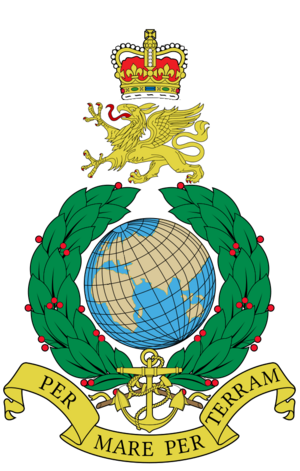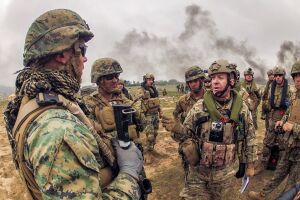Royal Marines (Aquitayne)
This article is incomplete because it is pending further input from participants, or it is a work-in-progress by one author. Please comment on this article's talk page to share your input, comments and questions. Note: To contribute to this article, you may need to seek help from the author(s) of this page. |
| His Majesty's Royal Marines | |
|---|---|
 Crest | |
| Founded | Marine regiments from 1598 Permanent marine forces from 1783 Titled "Royal Marines" in 1864 |
| Country | |
| Allegiance | Samuel Reich |
| Branch | His Majesty's Royal Navy |
| Type | Marine corps |
| Role | Expeditionary & amphibious warfare |
| Size | 57,109 Royal Marines |
| Office of the Commandant | Telora, Cirus, Aquitayne |
| Nickname(s) | Royals The Commandos |
| Motto(s) | "Per Mare, Per Terram" (Latin) "By Sea, By Land" |
| Colours | Blue Gold Red |
| Engagements | Great Astyrian War Second Great Astyrian War 2013 Invasion of Pangus |
| Commanders | |
| Commandant | Grand Field Marshal Gregory Lee |
| Assistant Commandant | Chief Marshal Harry Reginald |
| Insignia | |
| Ceremonial flag | |
The Royal Marines is a unit within the Aquitaynian Armed Services, and more specifically, the Aquitaynian Navy. It serves as Aquitayne's amphibious light infantry force, and was formed officially in 1783. Originally, they were formed as the Royal Navy's infantry troops, serving on board naval vessels as military police. However, the Royal Marines can trace their heritage back to the Battle of Valarus Bay, where the marines stationed aboard the HMS Judica disembarked from the ship and ran ashore to combat enemy forces in 1652.
As a highly specialized and trained fighting force, the Royal Marines are trained for rapid deployments worldwide and are capable of dealing with a wide range of threats. The Royal Marines are organized into a large Marine Expeditionary Force, which is further broken down into a Ground Combat Element, Air Combat Element, and a Logistics Combat Element. The Royal Marines operate in all environments and climates, though particular expertise and training is spent on amphibious warfare, arctic warfare, mountain warfare, and expeditionary warfare. The Marines have also recently committed resources to Aquitayne's Rapid Reaction Force.
Throughout its history, the Royal Marines have seen combat in many conflicts, service alongside the Aquitaynian Army and almost entirely using Naval vessels to arrive at their destinations. In recent times, the Marines have been notably deployed to the 2013 Invasion of Pangus, the Aswickan Civil War, and the ViZo-Bhormakaro Conflict. The Royal Marines have close international ties with many nations, including Aswick, Symphonia, and Riysa.
History
18th Century
19th Century
20th Century
Today
Personnel

The Royal Marines remain a part of the Naval Service and are under the full command of the Commandant of Marines, and the Supreme Admiral of the Navy. The rank structure of the Royal Marines is similar to the Army, with officers and other ranks recruited and trained separately from other naval personnel. Women are permitted to serve in the Royal Marines in non-combat roles, as is uniform with all other branches of the Aquitaynian military. On average, 2,500 recruits and 5,000 potential recruits, and 500 potential officers attend training courses and acquaint courses at NSK every year.
Formerly, the height of the Royal Marines stretched to over 70,000 personnel during the Second Great Astyrian War. However, that number is planned to be surpassed in the next ten years, with Aquitaynian ministers and general staff intending to add an additional 50,000 Marines for a total of 100,000 Royal Marines.
As of April 2016, the Royal Marines had a fighting strength of 57,109 personnel.
Equipment
Infantry The basic weapon of the Royal Marines is the IFAM AR5R1 infantry rifle, with varying attachments depending on mission parameters and requirements. Support fire is provided via the MG3/MG3R1, and the AR3/mod LF SMG. Indirect fire is supported via the L16A2 81mm mortar. Sniper rifles used include the SR10R1, a .338 or .50 caliber rifle, and the L115A3.
Armor The Royal Marines maintain few heavy armored units, and usually intend for a fleet of lightly armoured and highly mobile vehicles intended for amphibious landings or rapid deployment. Some of the vehicles the Royal Marines use include the HT9A7 (Block II) MBT, the MA9A2 APC, and the Joint Light Tactical Vehicle.
Artillery Artillery support is comprised of the M119 howitzer, the YrC9 Arkantyr 155mm Self-Propelled Howitzer, and the L118 light gun.
Aviation The aviation component of the Royal Marines is comprised of multiple aircraft spanning the fixed wing and rotor wing spectrum. The air components consist of the F-29B VSTOL, the EA-18G Growler, the T565 Modular Tanker/Transport, the RQ-6 Outrider UAV, the MV-22 Osprey, the AHU-2 Pirahna, the TH-300 Lakota, and the M.Cs 82 and 82/D variant.
Formation and structure
Marine Expeditionary Force
The main structure of the Royal Marines is comprised of the Marine Expeditionary Force, a combat unit of roughly 50,000 soldiers designed to rapidly deploy against any threat anywhere around the world within 72 hours. Currently, the entirety of the Royal Marines consists of a single MEF, I MEF, though there have been recent announcements of an additional MEF being planned in the large budget increase planned for the Ministry of Defense.
I MEF has existed since 1918, when it was officially formed as the master-structure of the Royal Marines. Back then, the Royal Marines consisted mostly of infantry troops and military police that kept sailors in order on the ships of the nation. During the Great Astyrian War, the Royal Marines would experiment in amphibious warfare operations, which would ultimately lead to the Royal Marine's selective nature and rapid deployment capabilities.
Marine Expeditionary Unit
The Marine Expeditionary Unit is a small combat group that is designed for stationing aboard Aquitaynian amphibious assault groups aboard the Drake Amphibious Assault Ship. The amphibious assault groups consist of two amphibious assault ships that hold two Royal Marine battalions each, providing for 4,800 light infantry and mechanized troops for rapid deployment anywhere around Astyria within 48 hours. There are currently three Marine Expeditionary Units, consisting of:
- The Command Element
- Two Ground Combat Elements of two battalions of Royal Marines
- The Aviation Combat Element, and
- The Logistics Combat Element
All told, a single amphibious assault group can provide for over 5,600 Royal Marines, which includes logistical support and staff.
Notable Marine Expeditionary Units include the First Marine Expeditionary Unit, which conducted amphibious assault operations during the 2013 Invasion of Pangus. Additionally, the Second Marine Expeditionary Unit is currently engaging enemy forces in the Aswickan Civil War.
